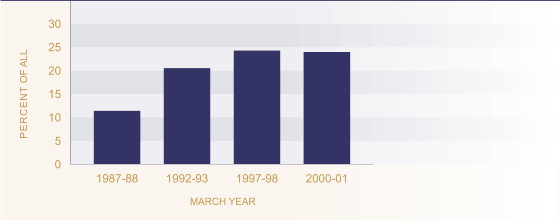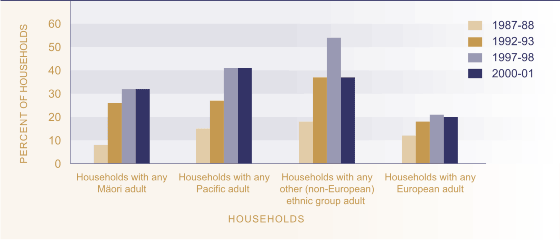Relevance
Affordable housing is an important factor in the wellbeing of individuals and families. High housing costs relative to income are often associated with severe financial difficulty, especially among low-income households, and can leave such households with insufficient income to meet other basic needs such as food, clothing, transport, medical care and education.
Current Level And Trends
In 2001, 24 percent of households spent more than 30 percent of their income on housing costs.
Since the late 1980s, there has been a substantial increase in the proportion of households spending more than 30 percent of their income on housing. Between 1988 and 1993 the proportion rose from 11 percent to 20 percent of households, reaching just over 24 percent in 1998. This is partly due to changes in household composition, and immigration and rising average incomes increasing the demand for housing and pushing prices up.
Figure EC5.1 Proportion of households
with housing cost outgoings-to-income ratio greater than 30 percent,
1988, 1993, 1998, 2001

Source: Statistics New
Zealand Household Economic Survey, Ministry of Social Development
Note: The weightings of the records in the sample have been revised for
all years since The Social Report 2001
High housing costs relative to household income are of greatest concern in respect of low-income households. Analysis of data on those households in the lowest 20 percent of the (equivalised) household income distribution shows a similar increasing trend over the 1988-2001 period but with significantly higher proportions of households spending more than 30 percent of income on housing.54 In 2001, 42 percent of households in the lowest fifth of the household income distribution spent more than 30 percent of their income on housing. This has increased from 16 percent in 1988.
It is important to remember this indicator will include some people whose high housing outgoings or low incomes represent only a temporary state of affairs, as, for example, they choose to make high mortgage repayments, or are temporarily out of work or in full-time study.
Age And Sex Differences
In 2001, 35 percent of children under 18 years were in households with housing costs exceeding 30 percent of income, a three-fold increase on 1988.
For people aged 15 years or over, females (22 percent) were a little more likely than males (20 percent) to be in households spending more than 30 percent of their income on housing in 2001.
Table EC5.1 Proportion of the population in households spending more than 30 percent of their income on housing, 1988, 1993, 1998, 2001
1987-88 % |
1992-93 % |
1997-98 % |
2000-01 % |
|
|---|---|---|---|---|
| Total population | 10.6 | 20.6 | 24.9 | 24.0 |
| Males (15 and over) | 10.3 | 18.8 | 21.0 | 20.1 |
| Females (15 and over) | 9.5 | 19.3 | 22.7 | 22.2 |
| Age groups | ||||
| Under 18 years | 11.9 | 27.1 | 37.1 | 34.7 |
| 18-24 years | 12.4 | 24.6 | 26.1 | 29.0 |
| 25-44 years | 14.7 | 26.3 | 31.1 | 28.2 |
| 45-64 years | 5.0 | 12.2 | 13.8 | 15.8 |
| 65 years and over | 3.2 | 4.0 | 7.1 | 7.2 |
Source: Statistics New
Zealand Household Economic Survey, Ministry of Social Development
Note: The weightings of the records in the sample have been revised for
all years since The Social Report 2001
Ethnic Differences
Housing costs in excess of 30 percent are much more common in households that include at least one non-European adult. For households with at least one Māori adult, the proportion increased from 8 percent in 1988 to 26 percent in 1993 and to 32 percent in 1998, remaining at that level in 2001. For those households containing at least one Pacific adult the increases have been greater, from 15 percent in 1988 to 43 percent in 1998 and 2001.
Figure EC5.2 Proportion of households
with housing cost outgoings-to-income ratio greater than 30 percent, by
ethnic group 1988, 1993, 1998, 2001

Source: Statistics New
Zealand Household Economic Survey, Ministry of Social Development
Note: The weightings of the records in the sample have been revised for
all years since The Social Report 2001
